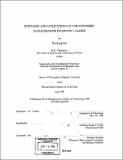Synthesis and applications of atropisomeric quinazolinone phosphine ligands
Author(s)
Dai, Xuedong, 1970-
DownloadFull printable version (6.588Mb)
Advisor
Scott C. Virgil.
Terms of use
Metadata
Show full item recordAbstract
Several novel atropisomeric phosphine ligands have been synthesized and evaluated. The syntheses of 2-methyl-3-[2'-(diphenylphosphino)phenyl]-4(3H)- quinazolinone (la) and its methyl-substituted analogs lb and ic were achieved in good yield by coupling N-acetylanthranilic acid with the corresponding phosphinoanilines 4a-c. A practical resolution of ligands la-c was accomplished using the benzenesulfonylhydrazone derivative (10) of (1S)-(+)-camphorsulfonic acid as a novel resolving agent. Several catalytic reactions including palladium-catalyzed asymmetric allylic alkylation, phosphine-catalyzed [3+2] cycloaddition of N-tosylimines with 2,3- butadienoate, and asymmetric intramolecular Heck reaction were performed. The 2-methyl group of this ligand series could be activated into the olefin form in the presence of Rh(nbd)2C104. The rhodium complex was found to be able to catalyze conjugate addition of the Grignard reagent (n-BuMgBr) to enones. The synthesis of 3-[4',6'-dimethyl-2'-(diphenylphosphino)phenyl]-4(3H)- quinazolinone (id) was achieved by coupling 4H-3,1-benzoxazin-4-one (71) with 4,6- dimethyl-2-diphenylphosphinoaniline (4c). Ligand ld could be directly lithiated by lithium diisopropylamide (LDA). The hetero-substituted analogs le-g were synthesized in good yield by quenching the lithium anion of ligand id with electrophiles. Resolutions of ligands id and le were achieved using (-)-di-p-chloro-bis[(S)-dimethyl-(1- naphthylethyl)aminato-C 2 , N]dipalladium(II) (78) and (-)-di-ji-chloro-bis[(S)-dimethyl-(1- phenylethyl)aminato-C 2 , N]dipalladium(II) (7), respectively.
Description
Thesis (Ph.D.)--Massachusetts Institute of Technology, Dept. of Chemistry, 1998. Includes bibliographical references.
Date issued
1998Department
Massachusetts Institute of Technology. Department of ChemistryPublisher
Massachusetts Institute of Technology
Keywords
Chemistry